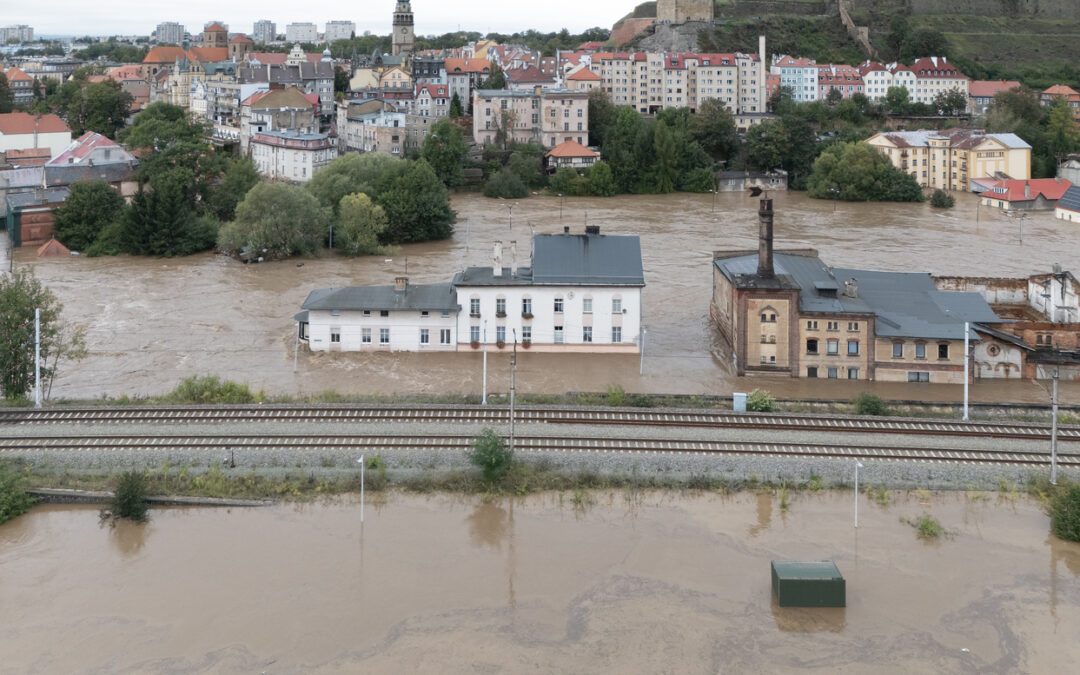Keep our news free from ads and paywalls by making a donation to support our work!

Notes from Poland is run by a small editorial team and is published by an independent, non-profit foundation that is funded through donations from our readers. We cannot do what we do without your support.
By Wojciech Kość
In September, parts of Lower Silesia in Poland’s southwest received six months’ worth of rain in the space of a few days. Water rushed down the steep slopes, overwhelming towns and shearing soil off arable land. The flooding claimed nine lives, displaced thousands of people, and left towns like Kłodzko and Stronie Śląskie in ruins.
The economic toll of the disaster is not yet clear, but the Polish government has pegged the cost of reconstruction at a staggering 23 billion złotys (€5 billion) in a political pledge made in late September to reconstruct and renovate infrastructure to a better standard than before the floods.
But a deeper reckoning is also taking place: an understanding that the flood was not a freak event appears to be dawning on decision-makers. With global temperatures climbing and extreme weather becoming more frequent, it is a future that is rapidly closing in on a country that – like most others – has been unable to keep pace.
Human-induced climate change made the extreme rainfall that caused recent deadly floods in Central Europe twice as likely and 7% more intense, a group of scientists has found
They warn that rising global temperatures will make such events even more common https://t.co/CKG0oU9EeW
— Notes from Poland 🇵🇱 (@notesfrompoland) September 26, 2024
“The climate crisis is visible to the naked eye. If humanity remains passive, instead of talking about a once-in-a-millennium flood, we will be talking about a millennium of floods,” climate and environment minister Paulina Hennig-Kloska told a parliamentary debate about the flooding in late September.
Even more ominously, Poland is one of Europe’s fastest-warming countries. That means not only persistent drought – which much of the country experienced even as the southwest was being inundated with water – but more rampant rain and higher risk of floods.
This forms the backdrop for a discussion that is now underway in Poland about how to prepare for the next floods. Much of this debate has centred on the role of flood reservoirs, like the giant basin Racibórz Dolny, designed to catch the deluge before it surges into towns.
During last month’s flood, Racibórz Dolny held – filling to the brim with nearly 150 million cubic metres of flood water and effectively saving Opole and Wrocław, large cities downstream on the Oder River. But many experts warn that relying on built infrastructure alone will not be sufficient.
“More comprehensiveness is needed, ranging from effective alert systems for the people to nature-based solutions,” says Sylwia Horska-Schwarz, a hydromorphologist and climate adaptation specialist from the University of Gdańsk.
According to Horska-Schwarz, Poland cannot simply engineer its way out of floods, and the debate that pits infrastructure against nature-based solutions is misleading and dangerous. “At the end of the day, people’s lives are at stake,” she says.
“Some of the reservoirs that were – or are – being planned might destroy more than they will save, for example habitats protected under [the EU’s] Natura 2000 [network],” Horska-Schwarz adds. “In other places, people will have to be relocated, as building in flood plains has become a new norm.”
However, the scientist also notes that those in favour of nature-based solutions also have to compromise, given that in mountainous river basins, such as those in Lower Silesia, there is not enough retention capacity.

The dam in Stronie Śląskie after bursting during the floods (credit: Jacek Halicki/Wikimedia Commons, under CC BY-SA 4.0)
Ilona Biedroń, from Poland’s state Institute of Meteorology and Water Management, emphasises the importance of ditching the mindset that dictates solutions aimed at controlling nature when designing safeguards against extreme weather events.
“For decades, we have used the concept of ‘flood protection,’ which suggests building reservoirs or new embankments to shield us from floods,” says Biedroń.
She points out that the EU legislation defines floods as natural phenomena that cannot be prevented, introducing the concept of flood risk management rather than fully containing water surges, with the latter being an endeavour that is doomed to fail.
“It’s not only river reservoirs that can reduce a flood wave. The delay between rainfall and runoff is influenced by the topography of the catchment area, its geological structure and soil type, as well as land use and the actual condition of rivers in the area,” Biedroń says.
“It is worth assessing the effectiveness of nature-based solutions, such as river restoration and giving rivers back the space taken from them by humans. Also, reconsidering how forests are managed so they can absorb water better, or how drained agricultural land is handled, could be key,” she adds.
Artificially straightened rivers have created conditions that worsen flooding in Poland.@WojciechKosc looks at grassroots initiatives to restore rivers to their natural state in order to protect against floods and droughts as well as sustain biodiversity https://t.co/7egIhFOmCG
— Notes from Poland 🇵🇱 (@notesfrompoland) September 19, 2024
Horska-Schwarz warns that, regardless of what mix of infrastructural and nature-based solutions are put in place, this will still not be enough alone to contain flooding. It is therefore vital that systems are in place to get people out of harm’s way.
“There’s this lingering belief that hydrotechnical solutions alone will provide people security. But what happened in September shows that what’s really needed is a comprehensive system of protection, warning and evacuation,” the scientist says.
The country’s crisis management systems buckled under pressure during the September floods, Horska-Schwarz says. This suggests that Poland’s crisis communication systems are due an overhaul, including the introduction of satellite communication for emergency teams.
“Without a proper communication system, we’re flying blind,” Horska-Schwarz says.
Poland's government says that Russian-linked accounts have been seeking to "cause panic" by spreading false information regarding ongoing floods.
During the first four days of the crisis, it recorded a 300% increase in disinformation being shared online https://t.co/GzZ6WzUwf5
— Notes from Poland 🇵🇱 (@notesfrompoland) September 26, 2024
Money also needs to be poured into Poland’s water management agencies, so that they can better implement and prioritise emergency responses, says Tomasz Kowalczyk of the University of Wrocław, who studies the management of the country’s water systems.
“Who gets to decide how much water is let in and out of a reservoir in an emergency? It can’t be energy companies,” Kowalczyk says, referring to the fact that some reservoirs that double as lakes in normal times also feature hydropower stations.
During last month’s floods, a blame game developed between a state energy firm and the water management authorities over who was responsible for the mass release of water from one such reservoir.
The two sides have different interests when it comes to carrying out such releases, and conflicts may become more common in future.
Recent floods gave Poland's government its most serious "stress test" since taking office, writes @AleksSzczerbiak.
But by taking personal charge of crisis management, @donaldtusk helped his administration emerge relatively unscathed politically https://t.co/zmkStYyDtF
— Notes from Poland 🇵🇱 (@notesfrompoland) October 15, 2024
“Systemic and financial support for the water management sector is needed in terms of management, salaries and education,” he adds “We need an effective system, capable of implementing adaptive measures proactively over the coming years.”
The government is yet to make it clear what its new strategy will be, although it appears to be leaning towards infrastructure-heavy solutions.
“We are indeed going to decide to build more reservoirs. We know very well what would have happened without Racibórz,” said Prime Minister Donald Tusk during one of the government’s crisis meetings in Wrocław in September.
“We also know that we must review and significantly strengthen infrastructure like that in Stronie Śląskie [where a dam burst].”
The government has put aside 1bn zloty (€234m) to support victims of ongoing major floods in Poland.
Those affected by the disaster will each be able to claim up to 10,000 zloty in immediate aid as well as larger amounts for long-term reconstruction https://t.co/RHafrfNJxC
— Notes from Poland 🇵🇱 (@notesfrompoland) September 16, 2024
The rapid pace of climate change, which will likely shorten the time between major weather events, makes such decisions all the more urgent.
“Such extreme rainfall events are naturally very rare but with ongoing warming and increasing water vapour content in the atmosphere, they will occur more frequently,” says Piotr Florek, a Polish climatologist with the website Nauka o klimacie (Climate Science).
“According to estimates from climate attribution experts, the frequency of this kind of rainfall has already roughly doubled compared to pre-industrial times,” Florek adds, referring to a study by scientists at World Weather Attribution, which concluded that climate change made the floods in September more likely and more intense.

Notes from Poland is run by a small editorial team and published by an independent, non-profit foundation that is funded through donations from our readers. We cannot do what we do without your support.
Main image credit: Jacek Halicki/Wikimedia Commons (under CC BY-SA 4.0)




















